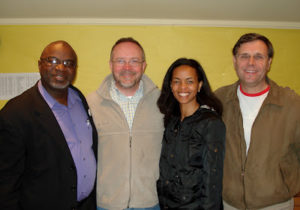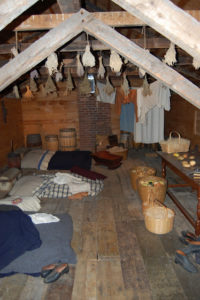Slaves in the Attic
by Joseph McGill
Joseph McGill is a Charleston, SC-based Field Officer for the National Trust for Historic Preservation. He arranges overnight stays in former slave dwellings as part of his personal mission: to bring awareness to and preserve the dwellings where African Americans lived while enslaved. As of this writing he has stayed in 35 different dwellings in 11 states. Joe recently conducted an overnight stay at the Bush-Holley House in Greenwich, CT where he was joined by CTTT members Grant Hayter-Menzies, Dionne Ford Kurtti, and Dave Pettee.
 My initial intent for the Slave Dwelling Project was all about saving places often overlooked by American history. It did not take long for the public to realize that someone spending a night in an extant former slave dwelling is indeed something worth noting. The media attention, the public programs and revelations of dwellings I never thought existed were all expected outcomes when I embarked upon this journey. One of the things I did not expect was that I would be planning a fourth year of stays for the project – a testament that the project is still relevant.
My initial intent for the Slave Dwelling Project was all about saving places often overlooked by American history. It did not take long for the public to realize that someone spending a night in an extant former slave dwelling is indeed something worth noting. The media attention, the public programs and revelations of dwellings I never thought existed were all expected outcomes when I embarked upon this journey. One of the things I did not expect was that I would be planning a fourth year of stays for the project – a testament that the project is still relevant.
Because I am just one individual, trying to show respect to my ancestors by bringing attention to the places that they once dwelled, I have aligned the project with like-minded individuals and entities. Amazingly, I do not have to find them–they find me. One group that found me was Coming To The Table. When I was given an invitation to engage with the group I could easily see where we could compliment each other’s efforts. Participating in CTTT’s National Gathering, in the presence of descendants of slaves and slave owners, was an experience I will never forget.
My connection with Coming To The Table was taken to another level on March 30, 2012 at the Bush-Holley House in Greenwich, Connecticut, where I spent a night in the attic slave quarters with three CTTT members–Dionne Ford Kurtti, a descendant of an enslaved and slave owner, and Reverend David Pettee and Grant Hayter-Menzies, both descendants of slave owners. It was the first time that I knowingly shared the slave dwelling experience with descendants of slave owners. I had met David and Dionne three weeks prior at CTTT’s National Gathering. Grant, who was instrumental in making the stay happen, I knew only through telephone conversations, Facebook and emails.
Prior to our stay, staff at the Bush-Holley House arranged for a panel discussion on the subject of slavery in the north. In addition to Grant, Dionne and Dave, the panel included Dr. Allegra diBonaventura, Assistant Dean of the Graduate School of Arts and Sciences, Yale University, and Dale Plummer, City Historian of Norwich and Chair of the Emancipation Proclamation Commemoration Committee.
We spoke to a standing-room-only crowd, with lots of questions asked afterwards. Trying to interact with all the people wanting attention after the discussion was a challenge, but a good problem to have.
I eventually ended up in the attic where we were to spend the night. It was there that the reporters wanted their interviews. Maneuvering in the space was a challenge. It was set up to be seen from an observation area. Allowing us to sleep there was the site curator’s worst nightmare and rightfully so. The attic was filled with artifacts, replicas and materials that depicted a space lived in by enslaved people, and allowing too many people could compromise its structural integrity. So only Grant and I were allowed sleep in the actual attic quarters. David and Dionne slept in the observation area. Luckily, we were only separated by 3 foot high plexiglass.
 Once the reporters left, the four of us went outside to perform a libation ceremony to the ancestors. Although we were only four people, the place, our backgrounds, and our reasons for being there made for some heartwarming and emotional moments.
Once the reporters left, the four of us went outside to perform a libation ceremony to the ancestors. Although we were only four people, the place, our backgrounds, and our reasons for being there made for some heartwarming and emotional moments.
Once back inside the attic, thanks to arrangements made by the publishers of my blog, I was able to communicate live with an audience through Facebook. The questions came fast and furious and I kept up as much as my Blackberry would allow, all the time being thankful that this project was compelling enough for people to want to engage in a live chat.
Afterwards, Dionne, Grant, David and I talked about how the house was threatened with demolition when I-95 was proposed. With our collective knowledge of how interstates were planned, we concluded this area had to have been an African American neighborhood. We talked about the challenges of ten enslaved people sharing a 25 by 20 foot attic that also coupled as storage space. We talked about the pushy reporter who tried to provoke us into saying things we might regret once we calmed down. We talked about how Coming to the Table brought us all together for this occasion. We talked about genealogical research and my disdain for same, and how I am thankful for people like the three of them who have the patience for research. We talked about the three of them being prolific writers and how I will be calling on them for inspiration for the writing I will eventually do for the Slave Dwelling Project. We talked about being the descendant of a slave owner and a slave, as is the case for Dionne. And then there was sleep.
By 6:30 am everyone was awake. I was happy to learn that no one accused me of talking in my sleep. Snoring yes, but not talking in my sleep. The conversation from the previous night continued when I bluntly asked David and Grant “Do you feel like outcasts for revealing the history of slave owning by your ancestors?” The answers they gave made it apparent that both of these men have drawn a line in the sand and will not retreat despite what ridicule that might come their way.
After talking to reporters on our way out, I left the Bush-Holley House feeling that my work with Coming To The Table has only just begun.
- Learn more about the Slave Dwelling Project
- News coverage in the Greenwich Citizen
- Video: Excerpts from Slaves in the Attic Panel Discussion
- Video: Excerpts from Slaves in the Attic – Overnight Conversations
Below are comments from Grant Hayter-Menzies and Dionne Ford Kurtti about their experiences at the Bush-Holley House.
Sacred Space: Sleeping in the Slave Quarters of Bush-Holley House in Greenwich, CT
By Grant Hayter-Menzies
“…to see them in decay because the master’s house is prettier or draws more tourist dollars, seems to me a second enslavement, another crime against the people who were born, lived, worked and died there, and maintained their character and courage.”
Despite what they represent, despite the history attached to them, slave dwellings are sacred spaces.
To see a dwelling which, for enslaved people, put four thin walls around a slave’s brief possession of night-time privacy, and realize that these cabins made possible the big houses where their masters slept in comfort, and to see them in decay because the master’s house is prettier or draws more tourist dollars, seems to me a second enslavement, another crime against the people who were born, lived, worked and died there, and maintained their character and courage. This is part of what makes slave dwellings beautiful to me. Despite enslavement, there wasn’t a slave who didn’t know how beautiful it was to be free.
I wondered what would happen when Joe, Dionne, Dave and I ascended to the room over the kitchen of the Bush-Holley House, unrolled our sleeping bags and lay down in that spare, chilly, creaking space, the shingles overhead rattling under rain showers. Lying there in the dark on ungiving boards, I had a moment of panic. For a brief instant I understood what a whole life in that space had been like—the lack of privacy from master and mistress, the enduring heat in summer and cold in winter without a murmur, the working every day knowing that if you stopped, the repercussions could involve not a warning letter from a supervisor but degrading threats to your dignity or personal safety. Despite my three friends in the room with me, I felt extraordinarily alone.
Then I thought back to an hour earlier, when we four had stood beneath a budding tree in the garden just outside the kitchen wing. In the damp darkness we took each other’s hands and poured libation to honor the people who had lived, worked and died here and in all the slave quarters up and down the eastern seaboard and across the South, those abandoned and gone and those still standing, by some miracle, waiting for Joe. I spoke to the memory of Candice Bush, the last slave emancipated in Greenwich, whose home we would be dwelling in that night. I also spoke of a slave named Rose Jackson. According to her tombstone in Old Saybrook’s Cypress Cemetery, which I visited the day before, Rose was born in 1778 and died in 1866. She served five generations of the family of General William Hart, whose house still stands down the street from the cemetery. “Faithful Ever in All Things” is engraved on her marble headstone. The love that this black woman shared with her white family seemed not to have died with her but to radiate from the marble, as if it had stood a long time in the summer sun. I saw that Rose was my grandmother, your grandmother, the grandmother of us all, and the good she did is still going on, like the sweet incense of age and intimacy that pervades the Bush-Holley House quarters.
I said “ashé” with the others. Before I slept, I said “ashé” to my white grandmother, too. She also knew that the greatest of things is love. This is what, for me, took a cold, dark room and made it and places like it sacred, giving me the privilege of sleeping and dreaming there with my family of the past and the present.
No Longer Silent
By Dionne Ford Kurtti
“…the lives of the slaves in that attic would no longer be silent or completely in the dark.”
When I was invited to join Joe McGill in his slave dwelling project, I leapt (or slept) at the opportunity. Over the past two years, I’ve admired Joe’s efforts to bring slave dwellings and their need to be preserved to the attention of the public by sleeping in any slave dwelling that will have him. So when his project brought him North, to the Bush-Holly House in Greenwich, CT, I was honored and thrilled to make the hour drive to join him, Grant Hayter Menzes, and Dave Pettee in an overnight stay.
At first, I was struck by the size of the dwelling. It was larger than I’d expected. In my research in to my family’s history, I’d encountered one other slave dwelling in Virginia, half the width of the attic. But that cabin was a higher, stand-alone structure, only a stone’s throw away from the big plantation house. Still it provided some measure of autonomy, a place where its inhabitants could speak freely and just be. Not so in the Bush-Holly House. Located in the historic home built by wealthy Dutch farmer Justus Bush, the slave quarter doubled as a storage space and food preparation area. Among the blankets and pillows, baskets of (fake) vegetables and herbs hang from the exposed wooden beams to give a feel of how it would have been in the late 1700s. Once the reporters and staff members of the Historical Society left and it was just the four of us, we all instinctively spoke in hushed tones, as if to not let other people overhear. That’s what it would have been like for the enslaved people there – a dwelling, but not much of a sanctuary. What must it have been like to have your only shelter be in the same house with your masters? When could the enslaved people there ever speak freely?
I am descended from both a slave and a slaveholder, but when I went searching for my family’s roots, I was really only interested in my enslaved ancestors’ story. I didn’t want to know about the people who had enslaved them even though their blood courses through me. Because slaves were property, the details of their lives exist almost entirely in the documents of the people who owned them, like the will where my great, great-grandmother was bequeathed along with cattle and farm equipment. It quickly became apparent that I could not learn anything about my enslaved ancestors without learning about the people who enslaved them.
It stands to reason that the opposite is true. If we want to fully understand how the historic towns that we now call home were established, we have to look at the lives of all the people who had a hand in planting those roots from those whose names live on in town halls to their slaves, whose names are largely forgotten, but whose sweat and blood tilled the soil. The Greenwich Historical Society understands this.
Coming across that slave cabin in Virginia was like finding a spring in the dessert, so rare was it for me to encounter an existing monument to the life of enslaved people, my people, who have mostly been eradicated from our minds and thoughts, which in turn eradicates me, makes me feel invisible. Having the chance to sleep in the Bush-Holley slave quarters was the equivalent of diving in to that spring, quenching my thirst to know more about slavery and how it informed the foundation of our country. These slave dwellings are sacred places and an opportunity to encounter them is a pilgrimage.
Before I went to sleep, I used my phone to send a good night email to my family and noticed a message from one of my genealogy buddies whose ancestors are from the same town as mine, Ocean Springs, Mississippi. Our enslaved ancestors are buried in the same Mississippi cemetery and we think we may even be distant cousins. She asked that I please touch the wall of the Bush-Holley cabin and whisper her ancestor’s name.
I said, “Johanna” into the still Connecticut air, “Tempe” and “Eliza,” my own enslaved ancestors, “59” the number of souls my great, great-grandfather enslaved before selling them and “Candace” who had inhabited that attic.
Silent in the attic, completely in the dark, I could hear rain on the roof as I closed my eyes to go to sleep. I rested well, a feat for me, because it usually takes me a long time to still my mind enough to go to sleep. Maybe it’s because I knew that by being there with my friends in preservation solidarity, the lives of the slaves in that attic would no longer be silent or completely in the dark.

